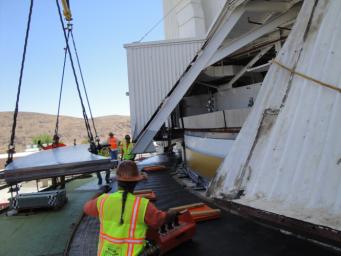
|
New Joints for a Workhorse Antenna
- Click the image above for a larger view
- Full-Res JPEG (4000 x 3000) (1.1 MB)
- Full-Res TIFF (4000 x 3000) (36.0 MB)
Caption:
Workers in Goldstone, Calif., guide a new runner segment into the hydrostatic bearing assembly of a giant, 70-meter-wide (230-foot-wide) antenna that is a critical part of NASA's Deep Space Network. The work gives the antenna a kind of joint replacement. The antenna is officially called Deep Space Station 14, but is also called the "Mars antenna." The nickname came from its first task: to track NASA's Mariner 4 spacecraft after the spacecraft's historic flyby of Mars in 1966.
During the spring and summer of 2010, workers replaced two kinds of joints in the 70-meter Goldstone antenna: the elevation bearings and the azimuth hydrostatic bearing. The elevation bearing enables the antenna to tip horizon to zenith and the hydrostatic bearing enables the antenna to turn sideways. This was the first time the hydrostatic bearing was replaced in this antenna.
A crane lifted each of the 11 new runner segments up to the base of the antenna -- about 10 meters (40 feet) off the ground. Workers at the base of the antenna then took control of the runner segment and lowered it gently onto air bearings. The air bearings work like an air hockey table, puffing pressurized air under the segments to allow workers to move them, virtually friction-free, around the base of the antenna.
The image was taken on July 26, 2010, when workers were in the middle of putting in the new segments.
Background Info:
The hydrostatic bearing assembly puts the weight of the antenna on three pads that glide around on a film of oil around a large steel ring. The ring, known as the runner, is 24 meters (80 feet) in diameter and needs to be flat to work efficiently. After 44 years of near-constant use, the runner surface had become uneven. Engineers and managers at NASA's Jet Propulsion Laboratory in Pasadena, Calif., which manages the Deep Space Network for NASA, have chosen a new epoxy grout that is much more impervious to oil and thicker runner segments with more tightly fitting joints.
JPL, a division of the California Institute of Technology in Pasadena, manages the Deep Space Network for NASA Headquarters, Washington. More information about the Deep Space Network is online at http://deepspace.jpl.nasa.gov/dsn/index.html .
Cataloging Keywords:
| Name | Value | Additional Values |
|---|---|---|
| Target | Earth | Mars |
| System | ||
| Target Type | Planet | |
| Mission | Deep Space Network (DSN) | Mariner |
| Instrument Host | Goldstone Deep Space Communications Complex (GDSCC) | |
| Host Type | Ground-Based Observatory | Flyby Spacecraft |
| Instrument | Deep Space Network Antenna | Goldstone Solar System Radar |
| Detector | ||
| Extra Keywords | Color, Radar, Radio | |
| Acquisition Date | ||
| Release Date | 2010-08-25 | |
| Date in Caption | 2010-07-26 | |
| Image Credit | NASA/JPL-Caltech | |
| Source | photojournal.jpl.nasa.gov/catalog/PIA13320 | |
| Identifier | PIA13320 | |
